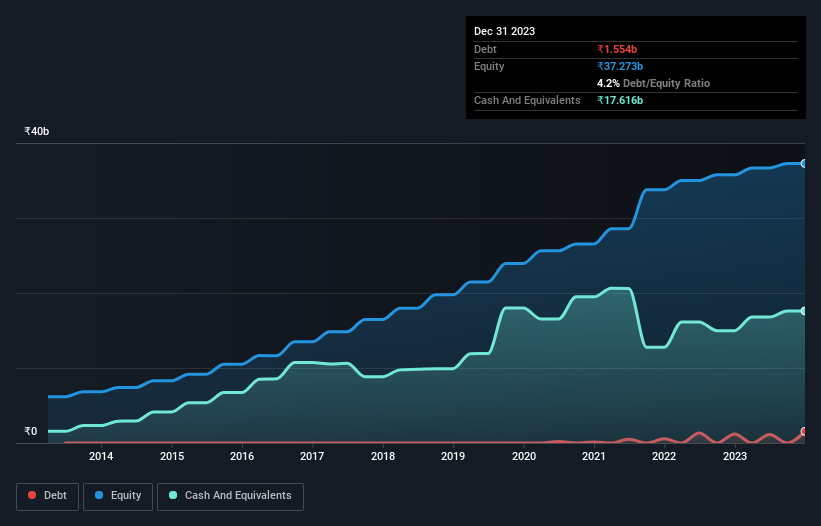- India
- /
- Consumer Durables
- /
- NSEI:WHIRLPOOL
Does Whirlpool of India (NSE:WHIRLPOOL) Have A Healthy Balance Sheet?

David Iben put it well when he said, 'Volatility is not a risk we care about. What we care about is avoiding the permanent loss of capital.' So it might be obvious that you need to consider debt, when you think about how risky any given stock is, because too much debt can sink a company. We note that Whirlpool of India Limited (NSE:WHIRLPOOL) does have debt on its balance sheet. But should shareholders be worried about its use of debt?
When Is Debt Dangerous?
Debt is a tool to help businesses grow, but if a business is incapable of paying off its lenders, then it exists at their mercy. Part and parcel of capitalism is the process of 'creative destruction' where failed businesses are mercilessly liquidated by their bankers. While that is not too common, we often do see indebted companies permanently diluting shareholders because lenders force them to raise capital at a distressed price. By replacing dilution, though, debt can be an extremely good tool for businesses that need capital to invest in growth at high rates of return. The first step when considering a company's debt levels is to consider its cash and debt together.
View our latest analysis for Whirlpool of India
What Is Whirlpool of India's Net Debt?
As you can see below, at the end of September 2023, Whirlpool of India had ₹1.55b of debt, up from ₹1.21b a year ago. Click the image for more detail. However, its balance sheet shows it holds ₹17.6b in cash, so it actually has ₹16.1b net cash.

How Healthy Is Whirlpool of India's Balance Sheet?
According to the last reported balance sheet, Whirlpool of India had liabilities of ₹13.7b due within 12 months, and liabilities of ₹4.22b due beyond 12 months. Offsetting this, it had ₹17.6b in cash and ₹2.03b in receivables that were due within 12 months. So it actually has ₹1.75b more liquid assets than total liabilities.
This state of affairs indicates that Whirlpool of India's balance sheet looks quite solid, as its total liabilities are just about equal to its liquid assets. So while it's hard to imagine that the ₹161.7b company is struggling for cash, we still think it's worth monitoring its balance sheet. Simply put, the fact that Whirlpool of India has more cash than debt is arguably a good indication that it can manage its debt safely.
In fact Whirlpool of India's saving grace is its low debt levels, because its EBIT has tanked 25% in the last twelve months. When a company sees its earnings tank, it can sometimes find its relationships with its lenders turn sour. There's no doubt that we learn most about debt from the balance sheet. But ultimately the future profitability of the business will decide if Whirlpool of India can strengthen its balance sheet over time. So if you're focused on the future you can check out this free report showing analyst profit forecasts.
Finally, a business needs free cash flow to pay off debt; accounting profits just don't cut it. While Whirlpool of India has net cash on its balance sheet, it's still worth taking a look at its ability to convert earnings before interest and tax (EBIT) to free cash flow, to help us understand how quickly it is building (or eroding) that cash balance. In the last three years, Whirlpool of India's free cash flow amounted to 31% of its EBIT, less than we'd expect. That's not great, when it comes to paying down debt.
Summing Up
While it is always sensible to investigate a company's debt, in this case Whirlpool of India has ₹16.1b in net cash and a decent-looking balance sheet. So we are not troubled with Whirlpool of India's debt use. When analysing debt levels, the balance sheet is the obvious place to start. But ultimately, every company can contain risks that exist outside of the balance sheet. For instance, we've identified 1 warning sign for Whirlpool of India that you should be aware of.
If you're interested in investing in businesses that can grow profits without the burden of debt, then check out this free list of growing businesses that have net cash on the balance sheet.
Valuation is complex, but we're here to simplify it.
Discover if Whirlpool of India might be undervalued or overvalued with our detailed analysis, featuring fair value estimates, potential risks, dividends, insider trades, and its financial condition.
Access Free AnalysisHave feedback on this article? Concerned about the content? Get in touch with us directly. Alternatively, email editorial-team (at) simplywallst.com.
This article by Simply Wall St is general in nature. We provide commentary based on historical data and analyst forecasts only using an unbiased methodology and our articles are not intended to be financial advice. It does not constitute a recommendation to buy or sell any stock, and does not take account of your objectives, or your financial situation. We aim to bring you long-term focused analysis driven by fundamental data. Note that our analysis may not factor in the latest price-sensitive company announcements or qualitative material. Simply Wall St has no position in any stocks mentioned.
About NSEI:WHIRLPOOL
Whirlpool of India
Manufactures and markets home appliances in India and internationally.
Excellent balance sheet with reasonable growth potential.
Market Insights
Community Narratives




